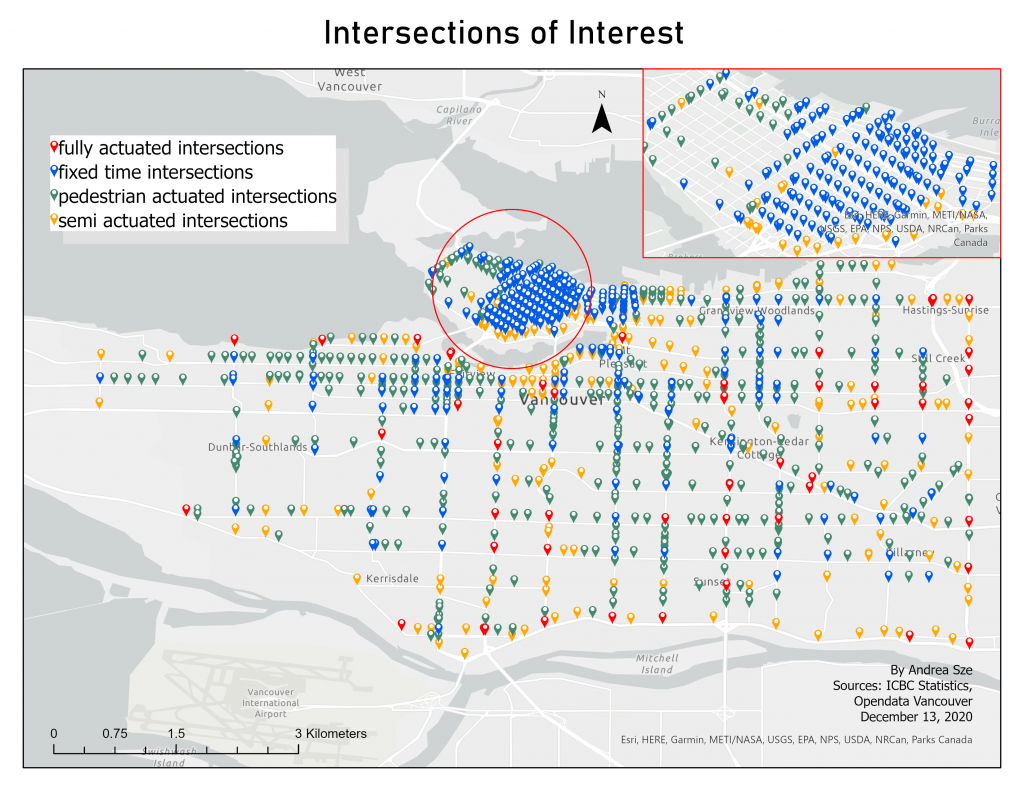Background
Traffic lights are designated to certain intersections based on the flow of traffic at the intersection. Some intersections need to regulate high flows of traffic, while some regulate little flow of traffic. Some, even regulate the mixture of both. Traffic lights seek to regulate the flow of traffic in a controlled manner to create the most efficient and safe traffic. To determine which signal light should be used, factors such as…
- pedestrian volume,
- pedestrian age and ability,
- roadway width,
- vehicular volume,
- speed,
- visibility conditions,
- the proximity of adjacent pavement markings, signs or signals and
- accident history.
…need to be considered. City planners take these into account to best manage traffic.
In Metro Vancouver, the four most common signal lights are semi actuated, fully actuated, pedestrian actuated, and fixed time. They are unique in their own way of managing types of traffic flows.
-
Semi actuated
These traffic lights are being used for intersections managing a crossroad of a major road and a crossroad with lighter traffic. The greenlight is sustained on the major road until a vehicle in the lighter traffic road triggers the signal so it can cross through the intersection. This allows for reducing road congestion on the major road by allowing a constant flow and only stopping when there is a vehicle in the side road.
-
Fully Actuated
A fully actuated light is similar to a semi caused signal. This type of light manages roads where traffic flow in the intersection varies throughout the day. Both crossroads has traffic lights to regulate the flow. But, unlike a fixed time, the change in signal lights is dependent on the flow of traffic.
-
Pedestrian actuated signal
Pedestrian actuated signals are like semi-actuated signals, except instead of side streets being activated by vehicle, pedestrians do so. They seek to regulate the same type of traffic as semi-actuated but instead where there are higher flows of pedestrians trying to cross the main street.
-
Fixed time
These traffic signals change at a pre-fixed time. They provide routine gaps in traffic flow to allow for a pedestrian to cross at a regular and consistent interval as well as for cars to turn. Fully actuated lights work best at managing traffic where both intersecting streets have high flows of traffic and pedestrians, like town centers.
Project focus
As a newly licenced class N driver in Metro Vancouver, I wanted to know which areas of Vancouver have the high rates of car crashes and what traffic light type it is associated it.
I analyzed the rates of traffic accidents at intersections of metro Vancouver intersections based on the type of traffic light installed. Accidents were based on ICBC’s 2019 report of accidents by insured vehicle owners, pedestrians and cyclists. What I will be asking is if there is a type of traffic light that is “safer”. I know that there are other factors that contribute to road collisions, but I wonder if rates of accidents can be reduced by looking at the distribution of traffic lights.
Traffic lights are placed at intersects to meet the needs of the specific flow of traffic at that intersection. Some may be controlling the high flow of traffic and some manage the low flow. So, by examining the traffic lights appointed to each intersection, I can see what type of traffic they manage as well. This told me what type of traffic patterns are most prone to traffic accidents. The four types of traffic lights I analyzed were as mentioned above: semi-actuated, fully actuated, pedestrian actuated, and fixed time.
Project Objectives:
- Identify areas where traffic accidents have a high occurrence
- Understand the placement of different traffic lights
- Identify which types of a traffic light has the highest occurrence of traffic incidents
